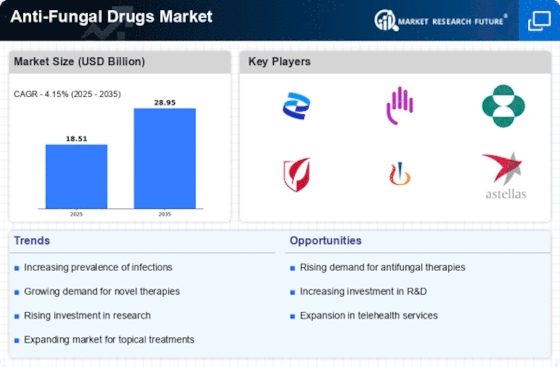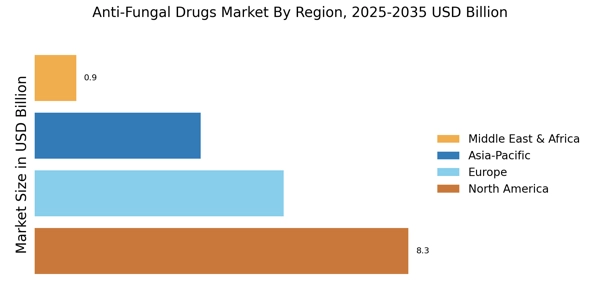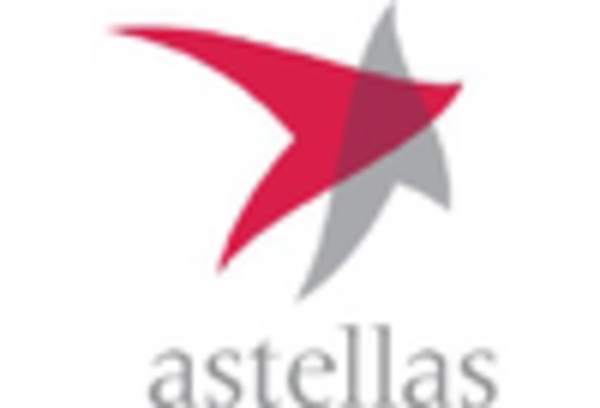Regulatory Support for Drug Approvals
Regulatory support for the approval of new anti-fungal drugs is enhancing the landscape of the Anti-Fungal Drugs Market. Regulatory agencies are increasingly recognizing the need for expedited review processes for anti-fungal medications, particularly those targeting resistant strains of fungi. This support is crucial in addressing the growing threat of antifungal resistance, which has become a significant public health concern. As a result, pharmaceutical companies are encouraged to invest in the development of novel therapies, leading to a more dynamic market environment. The anticipated increase in new drug approvals is likely to contribute to a more competitive Anti-Fungal Drugs Market, fostering innovation and improving treatment options for patients.
Rising Awareness of Fungal Infections
The increasing awareness regarding fungal infections is a pivotal driver for the Anti-Fungal Drugs Market. Educational campaigns and healthcare initiatives have led to heightened recognition of the symptoms and risks associated with these infections. As a result, patients are more likely to seek medical attention, prompting healthcare providers to prescribe anti-fungal medications. This trend is reflected in the rising demand for anti-fungal drugs, with the market projected to reach approximately USD 20 billion by 2026. The growing understanding of the impact of fungal infections on health, particularly in immunocompromised individuals, further emphasizes the necessity for effective treatment options within the Anti-Fungal Drugs Market.
Increase in Immunocompromised Populations
The rise in immunocompromised populations is a critical driver for the Anti-Fungal Drugs Market. Factors such as an aging population, the prevalence of chronic diseases, and the use of immunosuppressive therapies contribute to a higher susceptibility to fungal infections. This demographic shift necessitates the availability of effective anti-fungal treatments, as these individuals are at a greater risk of developing severe infections. Consequently, the demand for anti-fungal drugs is expected to escalate, with market analysts projecting a compound annual growth rate of around 6% over the next five years. The Anti-Fungal Drugs Market must adapt to meet the needs of this vulnerable population, ensuring that effective therapies are accessible.
Technological Innovations in Drug Formulation
Technological advancements in drug formulation are significantly influencing the Anti-Fungal Drugs Market. Innovations such as nanotechnology and targeted drug delivery systems are enhancing the efficacy and safety profiles of anti-fungal medications. These developments not only improve patient outcomes but also expand the range of available treatment options. For instance, the introduction of liposomal formulations has shown promise in increasing the bioavailability of certain anti-fungal agents. As a result, the market is witnessing a surge in new product launches, with several companies investing heavily in research and development. This trend is expected to propel the Anti-Fungal Drugs Market forward, potentially leading to a market valuation exceeding USD 25 billion by 2027.
Rising Incidence of Fungal Infections in Healthcare Settings
The rising incidence of fungal infections in healthcare settings is a notable driver for the Anti-Fungal Drugs Market. Hospital-acquired infections, particularly among surgical patients and those in intensive care units, have become increasingly prevalent. This trend is attributed to factors such as the overuse of antibiotics, which can disrupt normal flora and create opportunities for fungal infections to thrive. Consequently, healthcare providers are compelled to implement stringent infection control measures and ensure the availability of effective anti-fungal treatments. The market is responding to this challenge, with an expected increase in the demand for anti-fungal drugs, particularly those that are effective against resistant strains. This dynamic underscores the critical role of the Anti-Fungal Drugs Market in safeguarding patient health.


















Leave a Comment